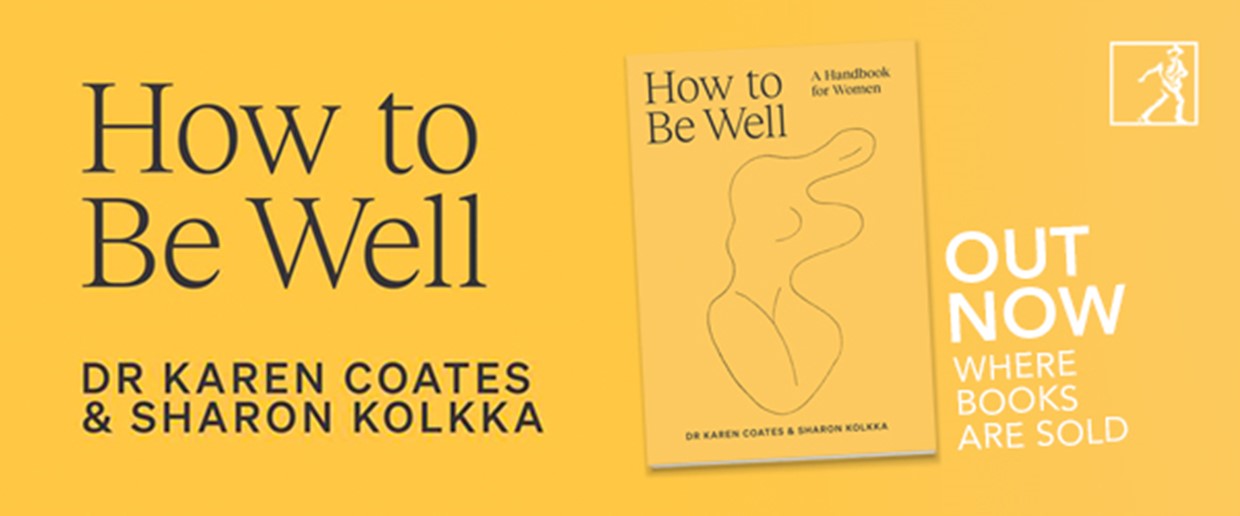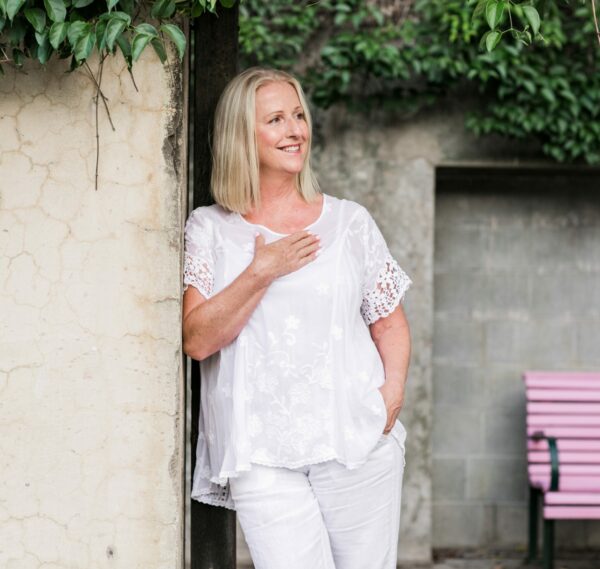We can’t talk about cultivating joy without talking about stress, and the role it plays in our health and wellbeing. In small doses, stress can be a force for good, but too much of it, and for too long, can have disastrous impacts on our wellbeing. To help you understand more about stress and your nervous system – including strategies to reduce stress right now – we’re sharing this brilliant extract of How To Be Well, A Handbook for Women, By Dr Karen Coates and Sharon Kolkka.
How To Be Well extract – Stress and the Nervous System
By Sharon Kolkka and Dr Karen Coates
Early humans were designed to deal with acute, life-threatening situations. Things such as finding shelter, dealing with famine and drought, war, invasion, natural disasters and the threat of an animal attack, all kept early man in a state of ‘fight or flight’. Today, in comparison, we have little real danger in our day-to-day life. Most of us are fortunate enough that we are not exposed to life-threatening situations on a daily, weekly or monthly basis.
Today, for most of us, the type of stress we face regularly is long-term, ongoing psychological or psychosocial pressure. These pressures mean that we can literally think ourselves into a physical stress response. This kind of stress is associated with relationships, finances, success, parenting, children, family and global events such as the Covid-19 pandemic. Anything that leads to you to a place of worry, anger, frustration or overwhelm fits the psychological/psychosocial stress category.
The Zones
Sharon’s idea for colour coding the nervous system came from her friend and horsemanship mentor Angie Wicks. This inspired Sharon to think about how this could be applied to humans: whether they are sympathetic reactive Red Zone or parasympathetic relaxed Blue Zone. Later came the Purple Zone, the ideal level to be in flow.
Much later she became aware that others around the world also colour coded the nervous system. (Dan Bron calls this ‘multiple discovery’, whereby discoveries are made independently and simultaneously.) We encourage you to explore other versions of colour-coded nervous system themes.
Dr Peter Parry M.B.B.S; F.R.A.N.Z.C.P, is a child and adolescent psychiatrist and a dear friend to us both. Dr Peter coined the phrase ‘S for Stress’ (Sympathetic) and ‘P for Peace’ (Parasympathetic) and has graciously given permission for the concept to be included here. Immense thanks to Dr Peter, whose work is essential to the understanding of mental health in children and adolescents, and for the compassion he shows for the human adult condition.
RED zone
The Sympathetic system (think ‘S’ for Stress), or the ‘Red Zone’, signals our body to be on alert when danger is real, or there is a perceived threat. This part of the nervous system activates the adrenal glands to release stress hormones into our bloodstream, which is how we may eventually arrive at adrenal fatigue.
When you are deeply in the Red Zone, you may feel:
- impatient
- intolerant
- irritable
- anxious
- overwhelmed
- frustrated
- fearful
Imagine you wake in the morning and before you open your eyes you are already thinking about how much you have to do today. The constant background buzz of worry and mind chatter, may sound something like ‘so much to do, so little time’. This kind of thinking is interpreted by the brain as threat and in milliseconds you find yourself in the Red Zone.
Really? Yes we know! Just thinking takes you to the Red Zone.
The brain interprets messages and images from the mind continually and needs to make distinctions between safe and unsafe thoughts and images. Often your brain activates the Red Zone as though you are facing a real threat.
The brain does not know the difference between what is real and what is imagined.
Have you ever woken from a nightmare? How does it feel when you wake up? You may notice your heart rate is up, you might be shallow breathing, feeling disorientated and scared? And, yet where are you when you wake up? In bed. And, unless there is someone in the room with you that should not be there, are you safe? Yes. So it is not your physical location or reality that took you to the Red Zone, it was the mental stimulus from your subconscious or dream state. This happens in conscious states all the time; you are physically safe, yet your mind is thinking unhelpful thoughts.
When you’re in the Red Zone, your thoughts may be negative and self-biased, such as ‘This always happens to me’.
Once you enter the Red Zone, your adrenal glands have already begun to release the stress hormones adrenaline and cortisol into your bloodstream. The amount of stress hormones released depends on the situation and the pressure you’re facing. Unrelenting pressure on the adrenal glands to produce these stress hormones may lead to a naturopathic diagnosis of adrenal exhaustion.
BLUE zone
Our Parasympathetic nervous system (think ‘P’ for Peace), or the Blue Zone, is the rest-and-digest part of the nervous system.
When you’re in the Blue Zone, you’ll most likely feel:
- peaceful
- relaxed
- calm
- patient
- loving
- creative
- content
- able to gain perspective
The roles of each of these two parts of our nervous system – the Red and Blue Zones – are very different and our body cannot be in both Zones at the same time.
When you’re in the Blue Zone, you will retain a baseline level of the stress hormone cortisol (related to the natural circadian rhythm); however, it is physically impossible to make adrenaline in this part of our nervous system. This is a good thing! This part of your nervous system has a very important and essential job.
When you spend time in your Blue Zone your body has the best capacity to:
- build and enhance your immune system
- protect gut microbiome
- improve deep sleep
- improve nutrient absorption
- heal and repair all cellular function
- allow you to feel content and relaxed
It’s our natural state to be in the Blue Zone often. Think of your Blue Zone time this way: your mobile phones and devices need regular recharging to work and function. The Blue Zone, at its very essence, is your recharging and repair station. If your phone has limited battery life it won’t work. Your body is the same. If you forget to charge your phone overnight, the following day can be extremely stressful. You’ll most likely spend time and energy looking for a place to recharge your phone so that it can function as you need it to. Your body is much the same. When you’re depleted or run out of energy, you will reach for caffeine, sugar, and other stimulants to push you through your fatigue. If you do not recharge your body properly, you have no residual charge to repair, heal or replenish your energy levels.
FACT
The more you use your mobile phone, the more often you will need to recharge it. The same applies to your body. The busier you are, the more you need to go to the Blue Zone to recharge and balance your nervous system.
PURPLE Zone
The best, most productive way to get things done, is when you are in the Purple Zone. Although the Purple Zone is technically in the sympathetic nervous system, you have the capacity to self-regulate and maintain an ideal, steady, slow release of stress hormones. This gives you the motivation you need and yet able to enjoy a calm level of excitement to perform your tasks. We call this the Purple Zone. This is the zone for productivity and performance, its where you find ‘your flow’, a calm, centred approach to work, family challenges and tasks.
When you are in the Purple Zone you may feel:
- motivated
- creative
- focused
- calm
- patient
- tolerant
- collaborative
This is the zone for productivity and performance. It’s where you find your ‘flow’, where you’re calm with a centred approach to work, family challenges and tasks. In this zone you are motivated, yet feel no irritation, impatience or intolerance. You are open to other people’s ideas. You are creative and most importantly, collaborative.
Are You Thinking Yourself Stressed?
Every day your thoughts and perceptions are racing. Are you paying enough attention to what is happening in your body?
Whilst you are living your busy life, your brain and body are working very hard to keep up with your ‘to do’ or ‘to be’ list. It’s likely that your body often considers itself to be in ‘danger’. Your body then responds by looking after its survival. The truth is: we are rarely in actual danger; we just think that way as the amygdala (the emotional, fear sensor) within the monkey brain is perceiving danger.
Our Thoughts Have Meaning and Consequences
As a result, your thoughts can hijack your body into the Red Zone. For instance, if your brain (remember the brain does not know the difference between what is real and what is imagined or perceived) considers a situation to be unsafe, that signal is then transmitted to your body. Being in this state for weeks, months or years is exhausting. While most of us are able to keep going, it tends to be due to coffee, sugar and adrenaline. Without these stimulants, you’re left only with deep exhaustion.
Research has shown us that long-term elevated stress hormones are the greatest contributor to the development of most medical diseases.
Remind yourself every day that your body is not a machine. It is a biological living organism with its own innate wisdom. If you give your body what it needs, it has an enormous capacity to self-regulate.
When you can maintain your nervous system in the Purple Zone while getting things done and then actively recharge and recover in the Blue Zone, you will have found the key to sustainability in life.
About the book
From two of Australia’s leading voices in women’s health and wellness comes this personal yet comprehensive handbook that will help every woman navigate her way back to optimal physical, mental and emotional health… because every woman deserves to be well. How to Be Well is available now through bookstores and online.

About the authors
Dr Karen Coates draws on her extensive experience as an integrative medicine doctor and qualifications in surgery, obstetrics, nutritional and environmental medicine. Over her thirty-year career she has cared for women of all ages who have come to her with diverse medical challenges. A keen researcher who keeps her finger on the pulse of cutting-edge medicine, Dr Karen is respected for her holistic approach to healthcare which extends beyond the traditional medical model while remaining evidence based.
Sharon Kolkka is one of Australia’s leading wellness advisors whose innovative approach to wellbeing shaped the highly successful and transformative programs at Gwinganna Lifestyle Retreat where she previously held the position of General Manager and Wellness Director. A trailblazer in the field of stress resilience, Sharon is highly regarded as a keynote speaker at wellness symposiums throughout Australia and around the world. She is a renowned thought leader, educator and wellness program designer.









